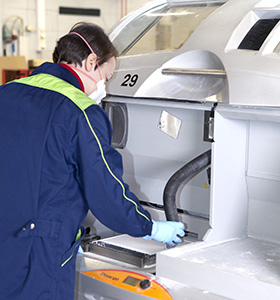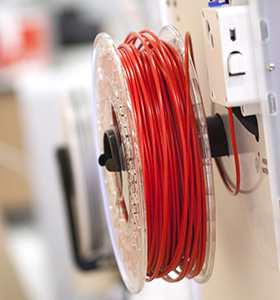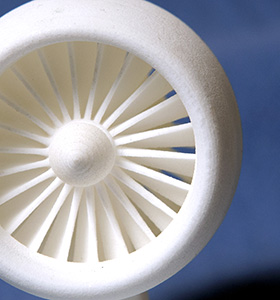New instructions: How to work safely with 3D printers
The Finnish Institute of Occupational Health, Aalto University and the University of Helsinki studied the safety of chemicals used in 3D printing.

Different chemicals such as solvents, epoxy chemicals and acrylate compounds, may be used in the manufacturing and finishing of 3D printed objects. Rashes linked to epoxy chemicals have already been reported among employees who perform 3D printing. To avoid harmful health effects, these chemicals must be handled safely. Special care should be taken, if epoxy resin is used as printing material or in finishing the printed products.
‘Epoxy resin is an extremely sensitising chemical, which means that it causes allergies. When you handle epoxy resin, you should use appropriate chemical-resistant gloves. In addition to this, you should protect your clothes against spatter and prevent surfaces from getting soiled with the chemicals’, stresses Helene Stockmann-Juvala, Senior Specialist at the Finnish Institute of Occupational Health.
‘You should already familiarise yourself with the safety data sheet of the product when you are choosing the chemical and try to choose the least harmful one. The safety data sheet will also provide instructions for how the chosen product can be handled safely and what kind of protection is needed.’
3D printing releases nanoparticles
When engaged in 3D printing, employees may be exposed to nanoparticles in the air they breathe. The concentrations depend on the printing technique, the material used and the printing temperature.
‘However, with safe working methods and appropriate protective measures, working with 3D printers is safe,’ reminds Anna-Kaisa Viitanen, Specialist Research Scientist at the Finnish Institute of Occupational Health.
 The study showed that nanoparticles and gases are released from 3D printers used in office-type workplaces. The strength of the emissions is affected by the printing material and the used printing temperature. Especially ABS plastics caused nanoparticle emissions, the effect of which on indoor air quality was examined with the help of modelling.
The study showed that nanoparticles and gases are released from 3D printers used in office-type workplaces. The strength of the emissions is affected by the printing material and the used printing temperature. Especially ABS plastics caused nanoparticle emissions, the effect of which on indoor air quality was examined with the help of modelling.
‘The results from modelling showed that, to keep concentrations at the recommended level, ordinary ventilation in an office is not sufficient during a long printing task that lasts for several hours,’ says Professor Kaarle Hämeri from the University of Helsinki.
Based on these research results, it is recommended that 3D printers should be placed away from the workstation to a space with good ventilation. Enclosing the 3D printer and directing the emissions out of the work facilities are effective ways to decrease harmful emissions into indoor air.
Industrial-scale printers are typically enclosed, and the number of particles released in the air during printing is consequently lower. Directing the air out of the work facilities or filtering the outgoing air improves the protective effect of the enclosure also in industrial environments.
Preliminary handling of 3D printing material may expose to dust from the material
Powder form 3D printing materials are typically used in industrial-scale printing and when they are used, possible exposure to dust that irritates the airways or the skin must be taken into account. In addition, some metal powders may be carcinogenic, so special care must be taken when handling them.
‘When handling powders you should pay attention also to preventing the dust from spreading by using appropriate working methods and, for instance, efficient local exhaust ventilation at the workstation in order to avoid possible irritation of the airways,’ Viitanen instructs everyone.
Small printers typically use filament printing materials that do not require any specific precautions when handled before printing.
Risk assessment should also take into account servicing and maintenance
‘People may also be exposed to 3D printing materials and the chemicals used when cleaning and maintaining printers, handling waste from printing and cleaning the work environment,’ reminds  Researcher Kirsi Kukko from Aalto University. In addition, the dust should be prevented from spreading. Vacuuming and wiping the surfaces with a damp cloth are good ways to do this.
Researcher Kirsi Kukko from Aalto University. In addition, the dust should be prevented from spreading. Vacuuming and wiping the surfaces with a damp cloth are good ways to do this.
The two-year research project was funded by the Finnish Work Environment Fund. The study focused on both small-scale and industrial-scale 3D printing. The project focused on examining the most commonly used printing materials and techniques, but the approach may also be applied to other 3D printing techniques.
The Finnish Institute of Occupational Health has published two sets of instruction as a result of the project, Malliratkaisu: 3D-tulostuksen kemikaaliturvallisuus työpaikoilla (‘Model solution: Chemical Safety in 3D printing at workplace’) and Tietokortti: Ohjeita turvalliseen 3D-tulostamiseen (‘Data card: Instructions for safe 3D printing’.
Further information:
Anna-Kaisa Viitanen, Specialist Research Scientist
Finnish Institute of Occupational Health
tel. +358 43 825 0672
anna-kaisa.viitanen@ttl.fi
www.ttl.fi
Helene Stockmann-Juvala, Senior Specialist
Finnish Institute of Occupational Health
tel. +358 43 8241 071
helene.stockmann-juvala@ttl.fi
Kirsi Kukko, Researcher
Aalto University
tel. +358 50 344 7248
kirsi.kukko@aalto.fi
Professor Kaarle Hämeri
University of Helsinki
tel. +358 9 19150 850
kaarle.hameri@helsinki.fi
www.helsinki.fi


